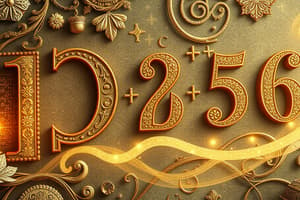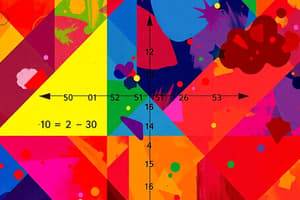Podcast
Questions and Answers
How do you subtract decimals?
How do you subtract decimals?
- Add the digits from left to right
- Ignore the decimal point
- Multiply the digits first
- Subtract the digits from right to left (correct)
What is the result of 1.1 + 1?
What is the result of 1.1 + 1?
- 3.2
- 2.1 (correct)
- 2.2
- 1.11
To multiply decimals, what should you do after aligning the decimal points?
To multiply decimals, what should you do after aligning the decimal points?
- Add zeros to align the number of digits (correct)
- Divide the digits
- Subtract the digits
- Round the result
When subtracting 12.34 from 19.78, what is the result rounded to two decimal places?
When subtracting 12.34 from 19.78, what is the result rounded to two decimal places?
Which step is essential when subtracting decimals?
Which step is essential when subtracting decimals?
What is the correct result of 12.34 multiplied by 7.89?
What is the correct result of 12.34 multiplied by 7.89?
Instructions: Identify the place
value of the underlined digit.
-
4.98432567
-
0.98231234442
-
0.0876
Instructions: Identify the place value of the underlined digit.
-
4.98432567
-
0.98231234442
-
0.0876
Instructions: Rename each decimal as a fraction and vice versa.
- 0.81 2. 9.845 3. 4 23/1000
Instructions: Rename each decimal as a fraction and vice versa.
- 0.81 2. 9.845 3. 4 23/1000
Round off 10.461 to the nearest tenth
Round off 10.461 to the nearest tenth
Round off 8.425 to the nearest hundredth
Round off 8.425 to the nearest hundredth
Round off 1.7872 to the nearest thousandths
Round off 1.7872 to the nearest thousandths
Compare. 3.76 ___ 3.83
Compare. 3.76 ___ 3.83
Compare. 2.345 ___ 2.354
Compare. 2.345 ___ 2.354
Compare. 0.05 ___ 0.5
Compare. 0.05 ___ 0.5
What does the second digit in the decimal 4.297 represent?
What does the second digit in the decimal 4.297 represent?
When comparing decimals, what should you do if the digits to the left of the decimal points are equal?
When comparing decimals, what should you do if the digits to the left of the decimal points are equal?
When adding decimals, what is the first step you should take?
When adding decimals, what is the first step you should take?
How do you compare decimals according to their values?
How do you compare decimals according to their values?
What is the result of subtracting 7.8 from 15.24?
What is the result of subtracting 7.8 from 15.24?
After aligning decimal points, what should you do when multiplying decimals?
After aligning decimal points, what should you do when multiplying decimals?
Flashcards are hidden until you start studying
Study Notes
Decimals: A Guide to Fractional Numbers
Decimals are a fundamental part of our numeric system, allowing us to represent and work with fractional amounts. In this article, we'll explore the essential aspects of decimals, including decimal places, comparison of decimals, and the four main operations (addition, subtraction, multiplication, and division).
Decimal Places
In decimals, each digit to the right of the decimal point represents a tenth of the previous digit's value. For instance, in the decimal 12.345, the first digit, 1, represents whole units, the second digit, 2, represents tenths, the third digit, 3, represents hundredths, and so on.
Comparing Decimals
To compare decimals, follow these steps:
- Compare the digits to the left of the decimal point. If they are equal, move to the next step.
- Compare the digits in the first decimal place. If they are equal, move to the next step.
- Continue comparing digits of the decimal places, moving from left to right, until you find a difference. The decimal with a greater value in the compared place is the larger number.
Decimal Addition
To add decimals, follow these steps:
- Line up the decimal points of both numbers.
- Add the digits from right to left, carrying over to the next column as needed.
For example, to add 12.34 and 7.89:
- Line up the decimal points: 12.34 | 7.89
- Add the digits: 1 + 7 = 8, carry 1 | 3 + 8 = 11, carry 1 8.1 | 1.1
- Add the carried digits: 1 + 1 = 2 ____ | 2.1
The result is 12.34 + 7.89 = 20.43.
Decimal Subtraction
To subtract decimals, follow these steps:
- Line up the decimal points of both numbers.
- Subtract the digits from right to left, borrowing from the previous column as needed.
For example, to subtract 12.34 from 19.78:
-
Line up the decimal points: 19.78 | 12.34
-
Subtract the digits: 1 - 1 = 0, no borrow | 9 - 2 = 7 9.78 | 7.34
-
Subtract the tens digit: 1 - 0 = 1, borrow 1 from the next column
9.7 | 7 _ 8 - 1 + 0.01 = 7.01 ____ | 7.34 - 0.01 = 7.33
The result is 19.78 - 12.34 = 7.44, rounded to two decimal places.
Decimal Multiplication
To multiply decimals, follow these steps:
- Line up the decimal points of both numbers.
- Multiply the digits from right to left, adding zeros as needed to align the number of digits.
- Add any decimal places that may result.
For example, to multiply 12.34 by 7.89:
-
Line up the decimal points: 12.34 | 7.89
-
Multiply the digits: 3 * 8 = 24, add zeros to align: 2400 4 * 7 = 28, add zero: 280 1 * 9 = 9, no zeros needed
2400 | 280 _____|_______ -
Multiply the numbers: 2400 * 28 = 67200 280 * 7 = 1960
67200 | 1960 _____|_______ -
Add any decimal places: 67200 + 196 = 67396
The result is 12.34 * 7.89 = 97.732, rounded to two decimal places.
The decimal number system allows us to represent and manipulate fractional parts of whole numbers, providing accuracy and precision in various fields, such as science, engineering, and finance. Understanding decimals and their properties is essential for working with and communicating numerical information.
Studying That Suits You
Use AI to generate personalized quizzes and flashcards to suit your learning preferences.




